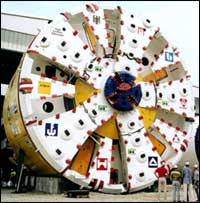Earth Sciences (also referred to as Geosciences), which deals with basic issues surrounding our planet, plays a vital role in the area of energy and raw materials supply.
Earth Sciences comprises subjects such as geology, geography, geological informatics, paleontology, mineralogy, petrography, crystallography, geophysics, geodesy, glaciology, cartography, photogrammetry, meteorology and seismology, early-warning systems, earthquake research and polar research.

Expertise derived from working on the joint NASA-ESA Cassini-Huygens mission to Saturn and its moon Titan is now being applied to underground drilling machines. This is providing tunnelling engineers with an improved ability to virtually “see” some 40 metres into solid rock and pinpoint obstacles ahead.
It´s an old miners´ expression: “There is darkness in front of the pick”. Billions of years of geological history has laid down complex folds of strata, patterns of faulting and embed

Deep convection, or mixing, of ocean waters in the North Atlantic, widely thought to occur in only the Labrador Sea and the Mediterranean, may occur in a third location first proposed nearly 100 years ago by the explorer and oceanographer Fridtjof Nansen. The findings, reported this week in the journal Nature, may alter thinking about the ocean’s overturning circulation that affects earth’s climate.
An international team of scientists reports in Nature that convection, a pr

Scientists from six institutions, including Scripps Institution of Oceanography at the University of California, San Diego, are closing the gap in deciphering one of the most puzzling aspects of the world’s oceans. “Ocean mixing,” the complex motions of seawater that span large-scale phenomena down to tiny, centimeter-sized turbulent motion, serves a key role in redistributing heat throughout the oceans. Although ocean mixing is a key element in the climate system and important for sea life for d

The largest single archaeological excavation in the UK, at the planned Terminal 5 at Heathrow Airport, has yielded an unprecedented insight into the way mankind has used the landscape over the last 8000 years.
A team of around 80 archaeologists has been working at the 100-hectare (250- acre) site of Terminal 5 for over a year and has found evidence of human activity going back to hunter-gatherers in the Stone Age, around 6,000BC, as well as Bronze Age, Iron Age, Roman, Saxon, Medieva

Dust from the Sahara Desert in Africa may help modify clouds and rainfall both in Africa and across the tropical North Atlantic, as far away as Barbados, according to a study that uses 16 years of data from NASA satellites, ground measurements and computer models.
The dust particles act as surfaces, or kernels, for water vapor to attach to in low clouds, and for ice crystals to form around in higher clouds.
The study’s authors, Natalie Mahowald, a researcher at the National C

During summertime ozone near the Earth’s surface forms in most major U.S. cities when sunlight and heat mix with car exhaust and other pollution, causing health officials to issue “ozone alerts.” But in other parts of the world, such as the tropical Atlantic, this low level ozone appears to originate naturally in ways that have left scientists puzzled. Now, NASA-funded scientists using four satellites can tell where low level ozone pollution comes from and whether it was manmade or natural.